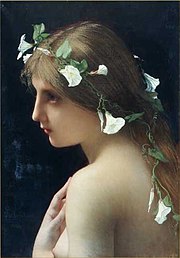Beauty
From Wikipedia, the free encyclopedia

Beauty is a characteristic of a person, place, object or idea that provides a perceptual experience of pleasure, meaning or satisfaction. Beauty is studied as part of aesthetics, sociology, social psychology and culture. As a cultural creation, beauty has been extremely commercialized. An "ideal beauty" is a person who is admired, or possesses features widely attributed to beauty in a particular culture. A number of historical individuals have become icons of beauty, including Cleopatra VII, Helen of Troy, and Marilyn Monroe.
The subjective experience of "beauty" often involves the interpretation of some entity as being in balance and harmony with nature, which may lead to feelings of attraction and emotional well-being. "Beauty is in the eye of the beholder" is a common phrase that expresses this concept.[1] In its most profound sense, beauty may engender a salient experience of positive reflection about the meaning of one's own existence. An "object of beauty" is anything that reveals or resonates with personal meaning.
The classical Greek adjective beautiful was καλλός. The Koine Greek word for beautiful was "ὡραῖος",[2] an adjective etymologically coming from the word "ὥρα" meaning hour. In Koine Greek, beauty was thus associated with "being of one's hour". A ripe fruit (of its time) was considered beautiful, whereas a young woman trying to appear older or an older woman trying to appear younger would not be considered beautiful. ὡραῖος in Attic Greek had many meanings, including youthful and ripe old age.[
No comments:
Post a Comment